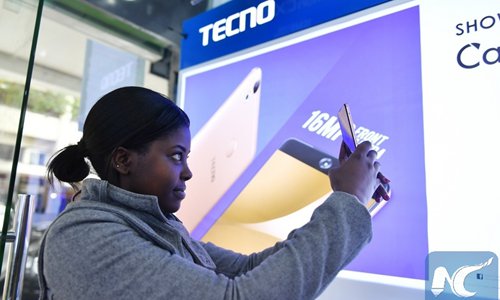HOME >> OPINION
Chinese smartphones ring loud in Africa
By Mark Kapchanga Source:Global Times Published: 2019/10/27 19:28:39

A customer takes selfies with Tecno mobile phone in downtown Nairobi, capital of Kenya, on May 9, 2017. Photo: Xinhua
About two decades ago, mobile telephones were a preserve of the well-off in Africa.
Back then, only fixed lines and letters were the key modes of communication. They were tedious and responses would take long. As such, they were not suitable for emergencies.
In remote regions, none of this was available. Instead, traditional forms of passing information around such as drum-beating and smoke were used.
However, as the wave of technological advancement swept the world, Africa was not left behind. In the late 1990s and early 2000s, Africans began buying mobiles most of which were not smartphones. That time, easy-to-use phones like Sony Ericsson, Sendo, Motorola and Nokia were popular.
These phones' functions, however, were limited to basic communication: receiving and making calls, text messages, and some connected to radio.
Besides being abnormally expensive, the recharging of these mobile phones was inconvenient to many. In those days, most homes were not connected to power, and those that were lucky to be linked to electricity experienced intermittent supplies.
What this meant is that it would at times take two or even more days for someone to recharge a mobile phone. This basically defeated the purpose the gadgets were designed for - communication.
The good thing with technology is that it is not static. Mid-2000s saw the birth of more sophisticated but expensive mobile phones with more functions apart from the basic ones. People could connect to the internet using the devices of new generation. The smartphones were therefore seen as new semi-computers in those days.
But the inventors of this technology seemed to have ignored the basic needs of some market niches such as Africa where a device with a long-lasting battery was preferred.
Worse still, the arrival of iPhones and Samsung mobile phones failed to take into account the rising demand for dual-SIM phones in the African market.
Having noticed these gaps in the market, Shenzhen-based phone maker Transsion echoed the Chinese government's "going out" strategy by entering Africa and forging tighter ties on the continent.
Today, in cities like Lagos, Nairobi, Kampala, Kigali, Harare and Addis Ababa, busy streets are dotted with the bright blue shop fronts of Transsion's flagship brand, Tecno. Billboards in the cities too scream out advertisements of the phone tagged: "Time to light up."
Apart from the fact that their batteries last longer than those of iPhone and Samsung, the Tecno mobile phones are valued for their tough bodies that can withstand harsh conditions such as breakages and the strong sun normally associated with Africa.
Crucially, they have two slots for SIM cards making it easy for the user to use one gadget for both business and family. For instance, the Tecno Camon is known in Africa for taking nice selfies. This is because the phone's cameras have been optimized for the complexion of people on the continent where the aperture lets in more light for darker skin.
After its strategy of "think global, act local," Transsion has also launched research and development centers in Kenya, China and Nigeria, and intends to open more - as demand for its products skyrockets - to work out how to better fulfill African consumers' needs. Already, the firm has added local African languages such as Amharic, Hausa and Swahili to keyboards.
This is more of an achievement for the brand compared to traditional players such as Nokia, Apple and Samsung whose devices use English even in Africa where literacy levels are still low.
But it is not just Transsion that is revolutionizing mobile telephony in African countries. Other Chinese smartphone makers such as Huawei and Xiaomi are giving Transsion tough competition in a market that is poised to be the world's largest following the launch of the Africa Continental Free Trade Area in March 2018.
The bloc, which allows the free movement of business travelers and investments and creates a continental customs union to streamline trade, brings together 54 countries and more than 1.27 billion people.
How these Chinese mobile phone makers will perform in Africa in the future is now hinged to how fast they would be responsive to the continent's needs such as the demand for tailor-made financial apps on smartphones. Importantly, apps on agriculture, weather, education and music would go a long way in defining Chinese phone makers' success path in Africa.
The author is a researcher and expert on China-Africa cooperation based in Nairobi, Kenya. Follow him on Twitter @kapchanga. opinion@globaltimes.com.cn
RELATED ARTICLES:
Posted in: VIEWPOINT